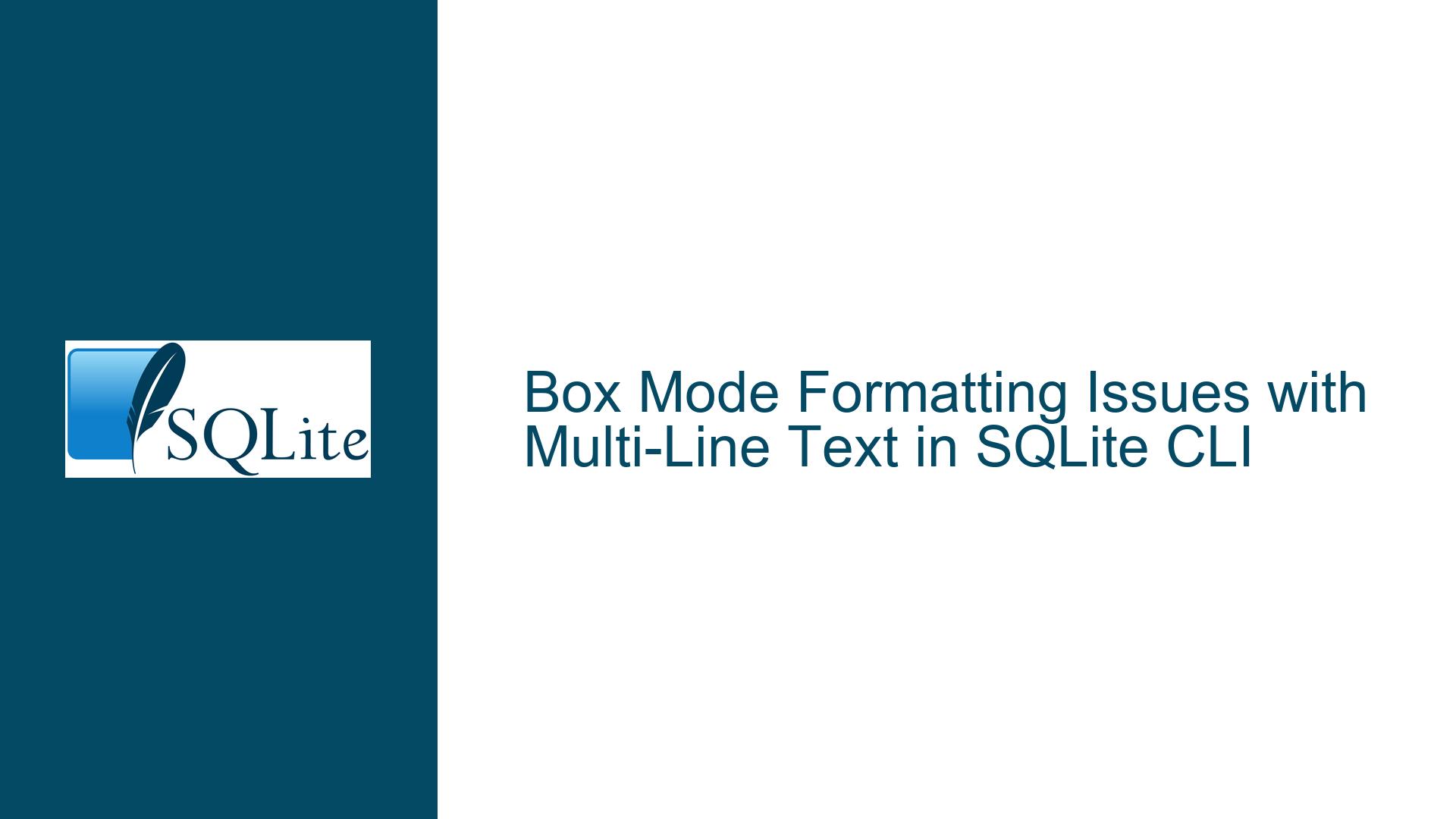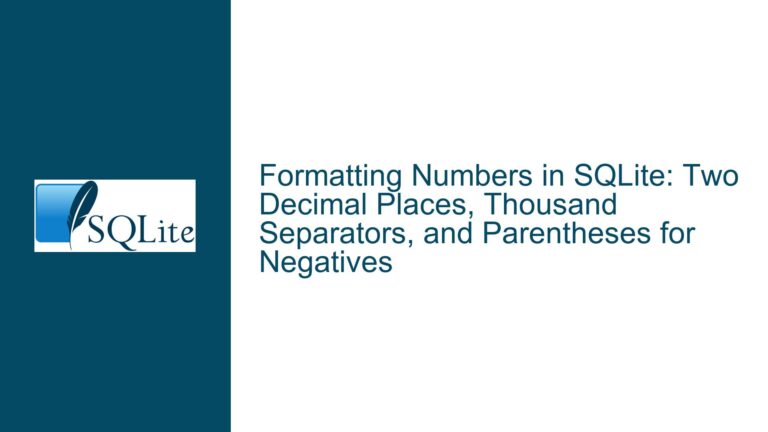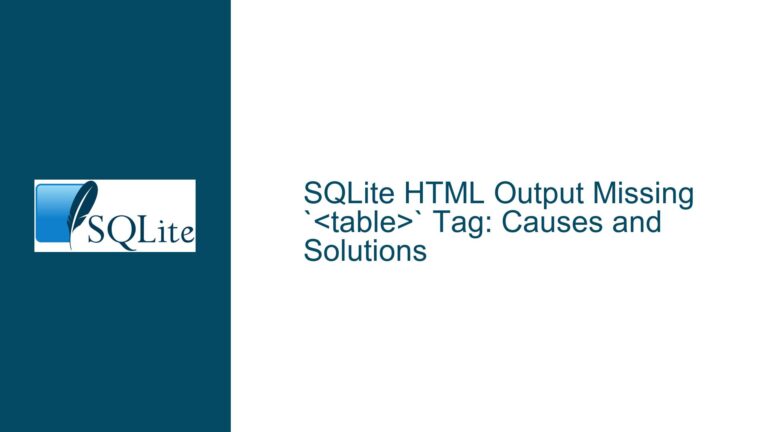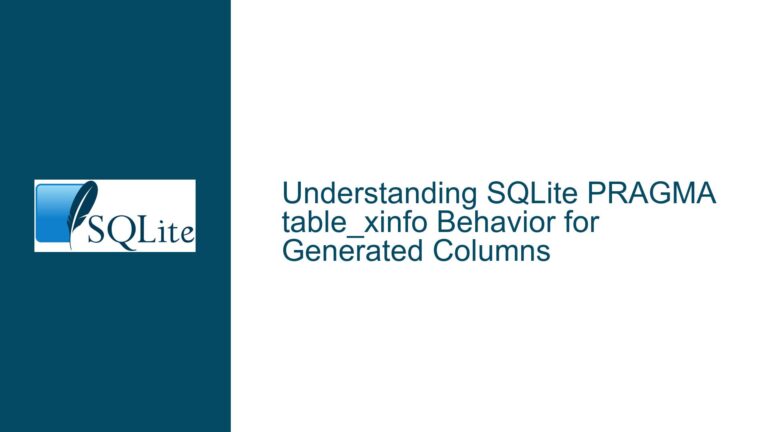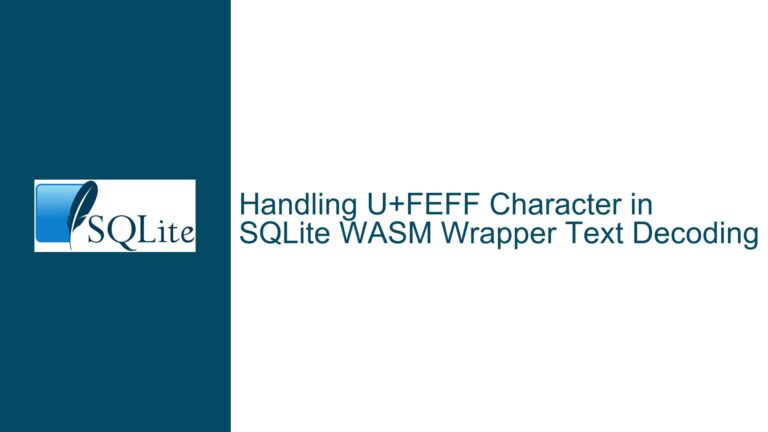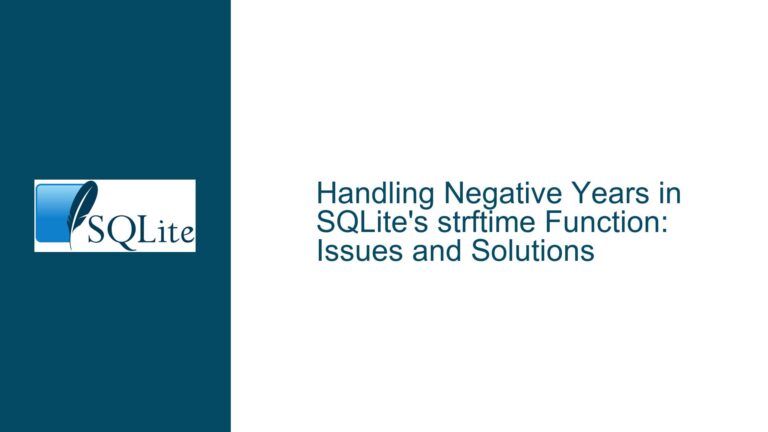Box Mode Formatting Issues with Multi-Line Text in SQLite CLI
Box Mode Multi-Line Text Formatting Challenges in SQLite CLI
Issue Overview: Box Mode Misalignment with Multi-Line Column Values
The SQLite command-line interface (CLI) provides several output formatting modes for query results, including the .mode box option introduced in version 3.22.0. This mode renders query results in an ASCII-art box format designed to make tabular data visually appealing. However, when column values contain embedded newline characters or long unbroken strings, the box formatting exhibits critical issues:
Vertical Alignment Disruption
Multi-line cell content causes subsequent rows to render with misaligned column boundaries. For example:┌───────┬───────────────┐ │ type │ sql │ ├───────┼───────────────┤ │ table │ CREATE TABLE meta (id INTEGER PRIMARY KEY, key INTEGER NOT NULL UNIQUE) │ └───────┴───────────────┘The line breaks in the
sqlcolumn disrupt the vertical alignment of the rightmost column border.Horizontal Overflow Artifacts
Long lines exceeding configured column widths wrap unpredictably, often splitting words mid-character and creating visual artifacts. This is exacerbated by:- Absence of word boundary detection in line wrapping
- Fixed-width column constraints conflicting with content length
Segmentation Faults (Historical)
Early implementations of enhanced wrapping features (e.g.,.mode qbox) in development builds caused memory corruption when handling tab characters or specific wrapping scenarios. These were subsequently patched but highlight the complexity of text processing in box mode.
Key Technical Constraints:
- Fixed Column Width Logic: Box mode calculates column widths based on the first row of data by default, which fails when subsequent rows contain multi-line content.
- Stateful Rendering: The CLI renders rows sequentially without precomputing maximum column widths across all rows, making dynamic adjustments impossible.
- Terminal Agnosticism: Unlike specialized tools like
lessorvim, the CLI doesn’t account for terminal resizing or smart pagination.
Possible Causes: Why Box Mode Struggles with Complex Text
1. Naive Text Wrapping Implementation
The box mode’s text wrapping algorithm prior to SQLite 3.38.0 used a simplistic approach:
// Simplified pseudo-code from sqlite3 CLI source
void print_box_row(Column* cols) {
for each line in wrapped_lines {
print vertical border;
for each column {
print cell_content substring with fixed width;
print vertical border;
}
print newline;
}
}
This implementation:
- Lacks Context Awareness: Each line of wrapped text is treated as a separate row segment without tracking vertical alignment across rows.
- Uses Greedy Wrapping: Lines are split at exact width limits regardless of word boundaries or hyphenation opportunities.
- Ignores Terminal Capabilities: Doesn’t use terminfo databases or ANSI escape codes for dynamic width adjustments.
2. Column Width Configuration Limitations
The .width command historically allowed setting only fixed widths per column. This created conflicts when:
- Columns contained variable-length data (e.g.,
TEXTvsINTEGER) - Multi-line cells required different widths for each wrapped line
- Users wanted maximum width constraints without enforcing minimums
3. Quoting and Escaping Interactions
When using --quote mode with box formatting:
- Additional quote characters (
') increased line length unpredictably - Escaped characters (e.g.,
\n,\t) were counted as multiple characters in width calculations - UTF-8 multi-byte characters weren’t properly handled in width computations
4. Memory Management Edge Cases
The segmentation fault reported in development builds stemmed from:
// Hypothetical faulty code from early .mode qbox implementation
char* wrap_text(const char* input, int max_width) {
char* buf = malloc(strlen(input) * 2); // Overestimate buffer size
int pos = 0;
while (*input) {
if (pos >= max_width) {
buf[pos++] = '\n'; // No bounds check!
pos = 0;
}
buf[pos++] = *input++;
}
buf[pos] = '\0';
return buf;
}
This code:
- Fails to account for tab expansion (tabs → multiple spaces)
- Doesn’t validate buffer writes after line breaks
- Uses raw
malloc()/free()alongside SQLite’ssqlite3_malloc()/sqlite3_free()
Troubleshooting Steps, Solutions & Fixes
1. Upgrading to SQLite 3.38.0+ with Enhanced Box Mode
Critical Fixes Introduced:
- Dual .width Parameters: Specify minimum and maximum column widths:
.width 0 0 0 0 80 -- Fifth column max 80 chars - –wrap Option: Global maximum width for unspecified columns:
.mode box --wrap 60 - qbox Shortcut: Combines box mode with quoting and smart wrapping:
.mode qbox -- Equivalent to .mode box --wrap 60 --quote
Verification Steps:
- Check SQLite version:
sqlite3 --version - Test multi-line formatting:
.mode qbox SELECT 'Line 1 Line 2' AS multiline;Expected output:
┌────────────┐ │ multiline │ ├────────────┤ │ 'Line 1 │ │ Line 2' │ └────────────┘
2. Configuring Column Widths and Wrapping
Optimal .width Settings:
- Mixed Fixed/Flexible Columns:
.width 10 20 0 0 60 -- First two columns fixed, others auto-wrap - Dynamic Adjustment:
WITH widths AS ( SELECT max(length(col1)) AS w1, max(length(col2)) AS w2 FROM my_table ) SELECT printf('.width %d %d', w1, w2) FROM widths;Redirect output to
.widthusing.onceand.read.
Advanced Wrapping Control:
- Word Boundary Detection (Custom Function):
CREATE TABLE lines AS SELECT 'Long text with spaces' AS text; .mode qbox .width 20 SELECT replace( substr(text, 1, instr(substr(text, 1, 20) || ' ', ' ', -1)), ' ', '\n' ) AS wrapped_text FROM lines;This splits lines at the last space within the width limit.
3. Alternative Output Modes for Complex Data
HTML Mode for Browser Rendering:
.mode html
.output report.html
SELECT * FROM sqlite_schema;
.print </table>
.shell xdg-open report.html # Linux
JSON Mode for Structured Parsing:
.mode json
.once data.json
SELECT * FROM table;
Custom Delimiters with .separator:
.mode csv
.separator "|" "\n"
.output data.csv
SELECT * FROM table;
4. Debugging Memory Issues in Development Builds
Identifying Corruption Sources:
- Valgrind Analysis:
valgrind --leak-check=full ./sqlite3 test.db - Address Sanitizer Build:
CFLAGS="-fsanitize=address" LDFLAGS="-fsanitize=address" ./configure make sqlite3
Common Pitfalls:
- Mixed Allocators: Replace
strdup()/free()with:char* sqlite_strdup(const char* s) { size_t len = strlen(s) + 1; char* dup = sqlite3_malloc(len); if (dup) memcpy(dup, s, len); return dup; } - Tab Handling: Expand tabs to spaces before wrapping:
void expand_tabs(char* s) { char* dst = s; while (*s) { if (*s == '\t') { do { *dst++ = ' '; } while ((dst - s) % 8 != 0); } else { *dst++ = *s; } s++; } *dst = '\0'; }
5. Workarounds for Legacy SQLite Versions
Preprocessing Multi-Line Text:
SELECT
replace(
replace(
sql,
char(10),
char(10) || '│' || printf('%*s', column_width - 1, ' ')
),
char(13), ''
) AS sql_fmt
FROM sqlite_schema;
This pads newlines with spaces to align subsequent lines.
External Formatting Tools:
sqlite3 db.db "SELECT sql FROM sqlite_schema" |
fold -w 80 -s |
awk '{print "│" $0 "│"}'
Batch Scripting with Dynamic Widths (Windows):
@echo off
setlocal enabledelayedexpansion
sqlite3.exe test.db ".headers on" ".mode csv" "SELECT sql FROM sqlite_schema;" > temp.csv
for /f "tokens=*" %%a in (temp.csv) do (
set "line=%%a"
echo │!line:~0,80!│
)
del temp.csv
6. Designing Schema for Box Mode Compatibility
Schema Formatting Best Practices:
- Avoid Inline Comments:
-- Instead of: CREATE TABLE t (id INT -- Primary key ); -- Use: CREATE TABLE t ( id INTEGER PRIMARY KEY /* Unique row identifier */ ); - Indent with Spaces: Replace tabs with 2-4 spaces for consistent wrapping.
- Constraint Organization:
CREATE TABLE meta ( id INTEGER PRIMARY KEY, key INTEGER NOT NULL UNIQUE, value TEXT NOT NULL );
View for Formatted Schema Access:
CREATE VIEW formatted_schema AS
SELECT
type,
name,
tbl_name,
rootpage,
replace(sql, char(10), char(10) || ' ') AS sql
FROM sqlite_schema;
7. Custom CLI Extensions for Enhanced Formatting
Registering a Text Wrapping Function:
#include <sqlite3ext.h>
SQLITE_EXTENSION_INIT1
static void sqlite3_word_wrap(
sqlite3_context *context,
int argc,
sqlite3_value **argv
) {
const char *text = (const char*)sqlite3_value_text(argv[0]);
int width = sqlite3_value_int(argv[1]);
char *result = word_wrap(text, width); // Implement this
sqlite3_result_text(context, result, -1, sqlite3_free);
}
int sqlite3_extension_init(
sqlite3 *db,
char **pzErrMsg,
const sqlite3_api_routines *pApi
) {
SQLITE_EXTENSION_INIT2(pApi);
sqlite3_create_function(db, "word_wrap", 2, SQLITE_UTF8, 0,
sqlite3_word_wrap, 0, 0);
return SQLITE_OK;
}
Usage:
.load ./wrap
.mode box
SELECT word_wrap(sql, 60) AS sql FROM sqlite_schema;
8. Terminal-Specific Optimization Techniques
Using Unicode Box Characters:
.mode box --utf8
Adjusts box-drawing characters for better Unicode support.
Terminal Font Configuration:
- Use monospace fonts with Powerline or Nerd Fonts patches
- Set
LC_ALL=C.UTF-8for consistent character width handling
Tmux/Screen Integration:
# Split window with formatted SQLite output
tmux new-window -n "SQLite" \
"sqlite3 -box db.db 'SELECT * FROM table' | less -S"
9. Automated Testing for Formatting Stability
Test Case Generation:
WITH samples(text) AS (
VALUES
('Short'),
('Long ' || replace(hex(randomblob(100)), '00', 'A')),
('Multi' || char(10) || 'line')
)
SELECT
CASE
WHEN instr(text, char(10)) THEN 'multiline'
WHEN length(text) > 20 THEN 'overflow'
ELSE 'normal'
END AS type,
text
FROM samples;
Regression Testing Script:
#!/bin/bash
set -euo pipefail
# Generate test data
sqlite3 test.db <<EOSQL
CREATE TABLE test (id INTEGER PRIMARY KEY, text TEXT);
INSERT INTO test(text) VALUES
('Single line'),
('Two' || char(10) || 'lines'),
(replace(hex(randomblob(200)), '00', 'A'));
EOSQL
# Run formatting tests
formats=(box qbox)
for fmt in "${formats[@]}"; do
echo "Testing .mode $fmt"
sqlite3 test.db ".mode $fmt" "SELECT * FROM test" > "output_$fmt.txt"
if ! grep -q '┌─────┬───────' "output_$fmt.txt"; then
echo "Failed $fmt border test"
exit 1
fi
done
10. Performance Considerations in Large Datasets
Impact of Wrapping on CLI Performance:
- CPU-Bound Operations: Wrapping 1MB text in box mode can take ~50ms on modern CPUs
- Memory Usage: Each wrapped line duplication increases memory consumption by 2-3x
Mitigation Strategies:
- Pagination with .limit:
.limit 10 100 -- Show 10 rows per page, max 100 rows - Progressive Rendering:
.mode async_box -- Hypothetical future mode - Index-Assisted Formatting:
CREATE INDEX idx_text_length ON articles(length(text)); SELECT id, substr(text, 1, 80) FROM articles WHERE length(text) <= 80 UNION ALL SELECT id, substr(text, 1, 77) || '...' FROM articles WHERE length(text) > 80;
Benchmarking Command:
time sqlite3 large.db ".mode box" "SELECT * FROM logs" > /dev/null
